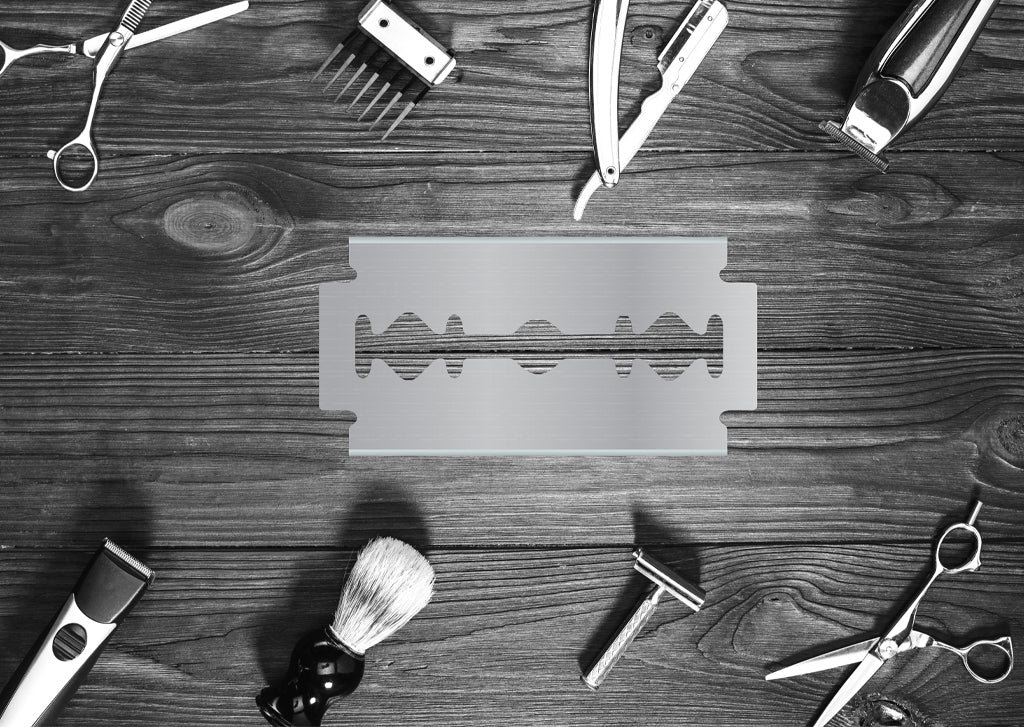All about razor blades
for safety razors and interchangeable blade razors

For many men around the world, daily shaving is an essential part of their grooming routine. One of the crucial tools for a successful shave with a safety razor or interchangeable blade razor are the razor blades. In this article, we'll take an in-depth look at the fascinating world of razor blades, from their historical development to how to make and choose the best blade for your needs.
History of Razor Blades
The history of shaving goes back thousands of years. The ancient Egyptians already used sharp obsidian blades (volcanic rock) to shave. But razor blades as we know them today have their roots in the 18th century. At that time, a significant advance occurred with the invention of the razor with replaceable blades. These safety razors quickly became popular and paved the way for modern shaving as we know it.
Manufacturing of razor blades
Manufacturing razor blades is a highly specialized process that requires precision and expertise. Most modern razor blades are made from stainless steel, a material that has proven to be ideal for its rust resistance and durability. This steel is processed in large rolling mills into thin sheets that form the basis for making the blades.
The manufacturing process begins with punching sheets into the shapes of the razor blades. These shapes are designed to create the characteristic, narrow, crescent-shaped blade required for a close shave. After the blades are stamped from the sheet metal, they undergo a series of grinding and polishing processes. These processes serve to bring the blade to the desired sharpness while ensuring a smooth, skin-friendly surface.
A crucial step in the production of razor blades is heat treatment. This process involves heating the blades to a specific temperature and then quickly cooling them. This changes the crystal structure of the steel, making it harder and more resistant to breakage and wear. Proper heat treatment is crucial to ensure the blade has the desired hardness and flexibility.
It is important to note that the exact manufacturing processes may vary from manufacturer to manufacturer. This leads to differences in the quality, sharpness, longevity and flexibility of the razor blades. Some manufacturers place a greater emphasis on precision and quality assurance, while others may prioritize mass production and cost optimization.
Differences between razor blades
There are many differences between different brands and models of razor blades. Some brands place an emphasis on the sharpness of their blades, resulting in an especially close shave. Others emphasize durability, meaning the blades stay sharp longer. Additionally, prices vary significantly, with both inexpensive and high-quality options available.
Razor blades for safety razors and interchangeable blade razors
Safety razors and interchangeable blade razors are popular tools for traditional wet shaving. Known for their simplicity, efficiency and sustainability, these razors use special razor blades called interchangeable blades.
These blades are typically made of stainless steel and are designed to be replaced once they are no longer sharp enough. Unlike disposable razors where the entire unit is thrown away, safety razors and interchangeable blade razors help reduce waste because only the blade itself is replaced.
The main advantage of razor blades for safety razors and interchangeable blade razors is their sharpness and precision. These blades are often sharper than disposable blades, resulting in a particularly close shave. Because they are replaceable, the user can change the blade as soon as it becomes dull instead of disposing of the entire razor. Not only does this save money in the long run, but it is also more environmentally friendly.
Find the right blade for you
Choosing the right razor blade depends on various factors, including your skin type, hair type and personal preferences. If you have sensitive skin, you might consider blades with a special coating to minimize skin irritation. For thick and frizzy hair, extra sharp blades might be the best choice.
Comparison of some razor blade brands
Feather, Astra, Gillette, Derby, Tiger, Kai, Mühle, Merkur, and Dovo: When it comes to choosing razor blades for safety razors and interchangeable blade razors, consumers are faced with a variety of options. Different brands offer a wide range of blades that vary in sharpness, durability, and price.
Feather: Feather blades are known for their extremely sharp blades. They are ideal for experienced users who want an extra close shave. However, the sharpness of Feather blades can be too aggressive for beginners and cause skin irritation.
Astra: Astra blades are a popular choice for many shaving enthusiasts. They offer a balanced mix of sharpness and comfort. Most users find them gentle on the skin yet effective at removing hair.
Gillette: Gillette is one of the most well-known brands in the razor blade space, offering a variety of models including disposable blades and wet razor blades. Gillette blades are typically comfortable and easily accessible, but they tend to be more expensive than some competing products.
Derby: Derby blades are a cost-effective option and are often preferred by beginners. They are generally milder and provide a smooth shave. The sharpness is slightly reduced compared to some other brands.
Tiger: Tiger blades are less well known, but have their fans. They offer a good combination of sharpness and price.
Kai: Kai blades are characterized by their excellent sharpness and are popular with professional hairdressers and barbers. They offer a close shave but require some experience to avoid skin irritation.
Mühle: Mühle is best known for its high-quality safety razors that can be used with matching blades. Mühle blades are known for their precision and durability.
Merkur: Merkur blades are another popular choice in safety razors. They come in a variety of sharpness options and provide a balanced shave that both beginners and experienced users appreciate.
Dovo: Dovo is known for its high-quality safety razors and straight razors. Dovo blades offer excellent sharpness and are highly valued by professional shavers.
Choosing the best razor blades depends on personal preference, skin type and experience. It may take some experimentation to find the ideal blade. Beginners may want to start with milder blades and work their way up gradually to determine the best blade for them. Experienced users can choose the sharpness and durability of the blades according to their needs.
Tips for proper shaving
A successful shave requires not only the right blade, but also the right technique. Start by thoroughly cleansing your skin and using a quality shaving gel or foam. Shaving against the direction your hair grows may give you a closer shave, but you also increase the risk of skin irritation and ingrown hairs.
Care and maintenance of razor blades
Caring for your razor blades is crucial to maximizing their lifespan. After shaving, you should rinse the blade thoroughly and make sure it is completely dry to prevent rusting. Some razors have special storage solutions that protect and dry the blades.
Sustainability and recycling
In the age of environmental consciousness, it is important to think about the ecological impact of razor blades. Disposable razors generate significant waste, while safety razors and reusable blades are more environmentally friendly options. Some companies also offer recycling programs for used blades.
Conclusion
Choosing the right razor blade is important to improve the quality of your shave and minimize skin irritation. Every person is unique, so it is important to take individual needs into account.
Final word
We hope this detailed article helped you better understand the world of razors and make the best possible choice for your shave. Careful blade selection can mean the difference between a painful experience and a comfortable shave.





Comments